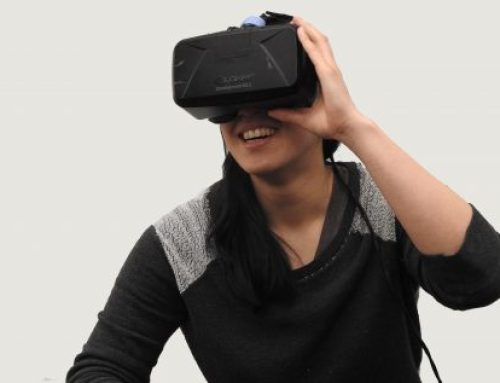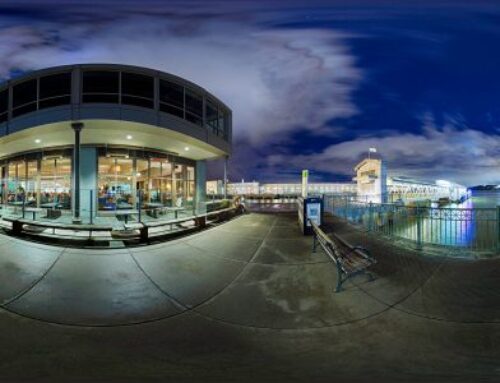Was Sie über WebVR und die Zukunft von VR wissen müssen.
Das Jahr 2017 wurde das Jahr der Virtual Reality (VR) genannt, mit so vielen verschiedenen Ereignissen, die sich über das gesamte Jahr erstreckt haben. Zu den bemerkenswertesten gehören sicher Vive und Oculus, die millionfach über den Ladentisch gingen. Google kündigte Daydream und Xiaomi/Tencent ein neues Head-Mounted-Display an. Die nächste große Veröffentlichung war Playstation VR, die zum Ende des Jahres 2016 auf dem Markt kam.
Unten sehen Sie eine Visualisierung des HTC Vive von Marco Romero:
Seitdem Headsets auf den Markt gekommen sind, ist auch erwartungsgemäß die Bedeutung des VR-Contents gestiegen. Bei Gaming- und Videostudios, die sich mit der Erstellung des Contents beschäftigen, ist der Output aber langsamer als von den frühen Anwendern erhofft. Darüber hinaus wird es aufgrund der kuratierten und proprietären Aspekte der VR App Stores lange dauern bis große Mengen an Content verfügbar sein wird und die Nutzer genau verstehen, welche Inhalte wo und für welches Headset verfügbar sind.
Glücklicherweise beeinflusst WebVR die Zukunft von VR positiv. Durch WebVR erfolgt die Verbreitung und Darstellung von VR in einer Headset-unabhängigen Art und Weise, die es den Content-Erstellern ermöglicht, VR-Erlebnisse zu erstellen und direkt über einen Webbrowser an die Konsumenten zu verteilen.
Während die Headset-Launches die ganze Aufmerksamkeit auf sich zogen, war 2017 auch für WebVR ein großartiges Jahr. Wir möchten hier die unglaubliche Arbeit von Entwicklern würdigen, die WebVR in den Browsern implementiert haben. Brandon & Josh bei Chrome, Vlad & Kearwood bei Firefox, Mike & Laszlo bei Samsung, Frank-Oliver bei Microsoft und viele mehr. Letzten Monat landete WebVR 1.0 im Firefox Nightly Build. Es ist geplant bis Ende des Jahres von Beta-Builds von Chrome zu einer ersten integrierten stabilen Version zu wechseln. Microsoft hat gerade die experimentielle WebVR-Unterstützung in Edge angekündigt. Kurzum, wir befinden uns an einem Wendepunkt für VR im Web. Es wird zur Realität. Sie können sich bereits mit einem Klick über ihren Webbrowser auf den Mars teleportieren:
Diese Möglichkeiten werden immer mehr zum Standard. Ich habe die letzten 5 Jahre damit verbracht, mir anzusehen, wie sich WebGL entwickelt hat. Anfänglich waren vorgestellte Konzepte zur Darstellung im Browser noch eher zum Lachen. Die Entwickler spezialisierten sich auf iOS und den Internet Explorer, viele glaubten aber, dass dies nie funktionieren würde. Das Potenzial einer Technologie zu verurteilen, indem man nur die heutige Situation beurteilt, verfehlt eindeutig den Punkt. Und wenn die Framerate anfangs umstritten war, dann ist sie heute recht solide und wird nur noch besser, wenn sich auch der Browser weiterentwickelt.
Die meisten VR-Inhalte sind heutzutage Spiele, die im Studio erstellt, bezahlt und heruntergeladen werden können. Aber wenn VR die nächste große Computerplattform werden soll, dann wird der Großteil der Inhalte nutzergeneriert, kostenlos, webbasiert und damit viel breiter sein als heute vermutet.
Warum ist WebVR so wichtig für die Zukunft von VR? Es gibt mehrere Gründe:
Distribution
Eine der am häufigsten auftretenden Fragen in der Welt der VR ist: Wie können wir Menschen dazu bringen, zu ihren Headsets zurückzukehren? Die Antwort der Branche war bisher, Inhalte über App Stores in die Headsets zu bringen. WebVR öffnet die Tür zu einem viel skalierbareren Ansatz und dieser lautet: Headsets zum Inhalt bringen. Wir sollten uns darauf konzentrieren, die Inhalte dorthin zu bringen, wo das Publikum ist, nämlich Facebook, LinkedIn, WordPress, Reddit, Twitter oder Google … all jene Online-Publishing-Plattformen, die im Vergleich zu den brandneuen VR-Appstores eine viel größere Reichweite haben. Die Verbreitung von Musik, Bildern und Videos hat sich deutlich erhöht, dies gilt auch für VR-Inhalte.
Cross-Plattform
VR ist im Moment sehr fragmentiert, Es gibt ein neues VR-Headset, das so ziemlich jede Woche auf den Markt kommt, mit einem eigenen Ökosystem. WebVR leistet viel Arbeit, um plattformübergreifende Kompatibilität zu ermöglichen. Mit anderen Worten: Es ist ziemlich einfach ein WebVR-Erlebnis mit allen Headsets kompatibel zu machen.
Unmittelbarkeit
Im Jahre 2018 möchte niemand mehr etwas herunterladen. Sie wollen Inhalte, die nur einen Klick entfernt sind. WebVR ist der einzige Weg, um VR zu erlauben, einen Klick entfernt zu sein.
WebVR bedeutet natürlich nicht, dass wir keine Appstores mehr brauchen werden. Spiele und Filme bieten eine bessere Experience, wenn sie heruntergeladen werden und viele Leute, die nach den Inhalten suchen, werden zu den App Stores gehen, um sie zu finden. Das Tolle daran ist, dass WebVR vollständig kompatibel mit nativen Anwendungen und App-Store-Distributionen ist. Ich erwarte, dass immer mehr native Anwendungen WebVR-Inhalte einbetten, so dass sie auch von der Verteilung in den Geschäften profitieren und das Web als skalierbare Infrastruktur nutzen können.


